Identifying patient subgroups in MASLD and MASH-associated fibrosis: molecular profiles and implications for drug development
- PMID: 39375498
- PMCID: PMC11458909
- DOI: 10.1038/s41598-024-74098-w
Identifying patient subgroups in MASLD and MASH-associated fibrosis: molecular profiles and implications for drug development
Abstract
The incidence of MASLD and MASH-associated fibrosis is rapidly increasing worldwide. Drug therapy is hampered by large patient variability and partial representation of human MASH fibrosis in preclinical models. Here, we investigated the mechanisms underlying patient heterogeneity using a discovery dataset and validated in distinct human transcriptomic datasets, to improve patient stratification and translation into subgroup specific patterns. Patient stratification was performed using weighted gene co-expression network analysis (WGCNA) in a large public transcriptomic discovery dataset (n = 216). Differential expression analysis was performed using DESeq2 to obtain differentially expressed genes (DEGs). Ingenuity Pathway analysis was used for functional annotation. The discovery dataset showed relevant fibrosis-related mechanisms representative of disease heterogeneity. Biological complexity embedded in genes signature was used to stratify discovery dataset into six subgroups of various sizes. Of note, subgroup-specific DEGs show differences in directionality in canonical pathways (e.g. Collagen biosynthesis, cytokine signaling) across subgroups. Finally, a multiclass classification model was trained and validated in two datasets. In summary, our work shows a potential alternative for patient population stratification based on heterogeneity in MASLD-MASH mechanisms. Future research is warranted to further characterize patient subgroups and identify protein targets for virtual screening and/or in vitro validation in preclinical models.
Keywords: Biological patterns; Heterogeneity; Individual variation; Liver disease; Patient stratification; Subgroup-specific pathways.
© 2024. The Author(s).
Conflict of interest statement
The authors declare no competing interests.
Figures








Similar articles
-
Deciphering the Underlying Mechanisms of Sanleng-Ezhu for the Treatment of Idiopathic Pulmonary Fibrosis Based on Network Pharmacology and Single-cell RNA Sequencing Data.Curr Comput Aided Drug Des. 2024;20(6):888-910. doi: 10.2174/1573409920666230808120504. Curr Comput Aided Drug Des. 2024. PMID: 37559532
-
NAFLD (MASLD)/NASH (MASH): Does It Bother to Label at All? A Comprehensive Narrative Review.Int J Mol Sci. 2024 Aug 2;25(15):8462. doi: 10.3390/ijms25158462. Int J Mol Sci. 2024. PMID: 39126031 Free PMC article. Review.
-
Improved biomarker discovery through a plot twist in transcriptomic data analysis.BMC Biol. 2022 Sep 24;20(1):208. doi: 10.1186/s12915-022-01398-w. BMC Biol. 2022. PMID: 36153614 Free PMC article.
-
Time-of-day-dependent variation of the human liver transcriptome and metabolome is disrupted in MASLD.JHEP Rep. 2023 Oct 27;6(1):100948. doi: 10.1016/j.jhepr.2023.100948. eCollection 2024 Jan. JHEP Rep. 2023. PMID: 38125300 Free PMC article.
-
Τ cell-mediated adaptive immunity in the transition from metabolic dysfunction-associated steatohepatitis to hepatocellular carcinoma.Front Cell Dev Biol. 2024 May 7;12:1343806. doi: 10.3389/fcell.2024.1343806. eCollection 2024. Front Cell Dev Biol. 2024. PMID: 38774646 Free PMC article. Review.
Cited by
-
Integrating text mining with network models for successful target identification: in vitro validation in MASH-induced liver fibrosis.Front Pharmacol. 2024 Sep 27;15:1442752. doi: 10.3389/fphar.2024.1442752. eCollection 2024. Front Pharmacol. 2024. PMID: 39399467 Free PMC article.
-
Fat, fibrosis, and the future: navigating the maze of MASLD/MASH.J Clin Invest. 2025 Apr 1;135(7):e186418. doi: 10.1172/JCI186418. J Clin Invest. 2025. PMID: 40166940 Free PMC article. No abstract available.
-
Μetabolic dysfunction-associated steatotic liver disease: a condition of heterogeneous metabolic risk factors, mechanisms and comorbidities requiring holistic treatment.Nat Rev Gastroenterol Hepatol. 2025 May;22(5):314-328. doi: 10.1038/s41575-025-01045-z. Epub 2025 Feb 17. Nat Rev Gastroenterol Hepatol. 2025. PMID: 39962331 Review.
References
-
- Schuster, S., Cabrera, D., Arrese, M. & Feldstein, A. E. Triggering and resolution of inflammation in NASH. Nat. Rev. Gastroenterol. Hepatol.15, 349–364. 10.1038/s41575-018-0009-6 (2018). - PubMed
-
- Schonmann, Y., Yeshua, H., Bentov, I. & Zelber-Sagi, S. Liver fibrosis marker is an independent predictor of cardiovascular morbidity and mortality in the general population. Dig. Liver Dis.53, 79–85 (2021). - PubMed
MeSH terms
Grants and funding
LinkOut - more resources
Full Text Sources

